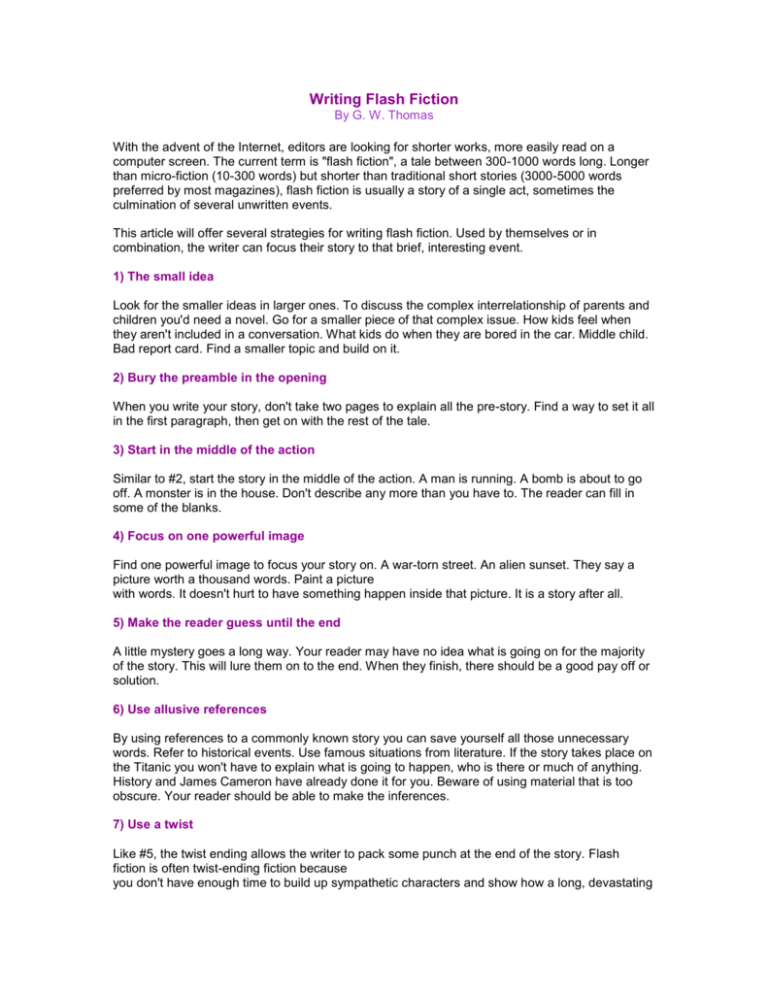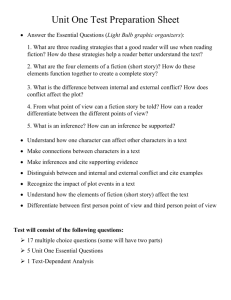Writing Flash Fiction
advertisement

Writing Flash Fiction By G. W. Thomas With the advent of the Internet, editors are looking for shorter works, more easily read on a computer screen. The current term is "flash fiction", a tale between 300-1000 words long. Longer than micro-fiction (10-300 words) but shorter than traditional short stories (3000-5000 words preferred by most magazines), flash fiction is usually a story of a single act, sometimes the culmination of several unwritten events. This article will offer several strategies for writing flash fiction. Used by themselves or in combination, the writer can focus their story to that brief, interesting event. 1) The small idea Look for the smaller ideas in larger ones. To discuss the complex interrelationship of parents and children you'd need a novel. Go for a smaller piece of that complex issue. How kids feel when they aren't included in a conversation. What kids do when they are bored in the car. Middle child. Bad report card. Find a smaller topic and build on it. 2) Bury the preamble in the opening When you write your story, don't take two pages to explain all the pre-story. Find a way to set it all in the first paragraph, then get on with the rest of the tale. 3) Start in the middle of the action Similar to #2, start the story in the middle of the action. A man is running. A bomb is about to go off. A monster is in the house. Don't describe any more than you have to. The reader can fill in some of the blanks. 4) Focus on one powerful image Find one powerful image to focus your story on. A war-torn street. An alien sunset. They say a picture worth a thousand words. Paint a picture with words. It doesn't hurt to have something happen inside that picture. It is a story after all. 5) Make the reader guess until the end A little mystery goes a long way. Your reader may have no idea what is going on for the majority of the story. This will lure them on to the end. When they finish, there should be a good pay off or solution. 6) Use allusive references By using references to a commonly known story you can save yourself all those unnecessary words. Refer to historical events. Use famous situations from literature. If the story takes place on the Titanic you won't have to explain what is going to happen, who is there or much of anything. History and James Cameron have already done it for you. Beware of using material that is too obscure. Your reader should be able to make the inferences. 7) Use a twist Like #5, the twist ending allows the writer to pack some punch at the end of the story. Flash fiction is often twist-ending fiction because you don't have enough time to build up sympathetic characters and show how a long, devastating plot has affected them. Like a good joke, flash fiction is often streamlined to the punch-line at the end. Let's look at these techniques in my story "Road Test". I wanted to write a story about taking my driving exam. I didn't mention the pre-test or practicing. Just the test. (#1 THE SMALL IDEA) This narrows our subject down to a manageable scene. I didn't have room to describe the driving examiner in detail. I set my main character in two sentences.(#2 BURY THE PREAMBLE) "The man in the government-issued suit sat down without looking at the person across from him. We've established the main character and his chief flaws. (He's mediocre and probably hates his job.) I started in the middle of the action by having the driver very quickly go from good driving to dangerous driving. Johnson, the driving examiner realizes the driver is not human but goat-headed (#3 START IN THE MIDDLE). "He had changed. The beard was longer, the skin darker and two large curved horns crowned his skull." This creates tension and has created an image: a man trapped in a speeding car with a monster (#4 A POWERFUL IMAGE). It pushes the reader on because they want to know what will happen next, maybe why is it happening? We won't tell them until the end (#5 KEEP THEM GUESSING). The monster keeps yelling the same word, "Pooka!" Johnson begins to understand. He knows the old fairy stories about the Pooka, about how they pretended to be horses so they could drown their victims. (#6 ALLUSION) Now is the time for resolution, our great twist ending that no one sees coming (#7 TWIST ENDING). As the monster crashes the car into a pond, Johnson realizes a modern-day Pooka wouldn't look like a horse, but would use a car. The car crashes and we finish with: "They would die, only Johnson would live long enough to feel those large goatish teeth chewing the flesh from his bones. The souped-up V8 hit the slick surface of the pond like a fist into jello. Windshield collapsed under tons of water, washing away the high, shrill laughter of the driver." "Road Test" clocks in at 634 words. It is essentially a man gets killed by a monster story, but the crux of the idea is "How would mythological creatures adapt to the modern world?" This is really the small idea. The allusions to the Pooka will work for some, but I gave enough explanation to help those that don't know about the old stories. This example story was chosen because it illustrated all 7 methods. Using only one in a flash story can be enough. Writing flash fiction is a great way for writers to write everyday, even when larger projects seem to daunting or they are pressed for time. Using these short cuts can have you writing in minutes. ----------------------------------------G. W. Thomas has appeared in over 100 different books and magazines. His micro story "NanoHunk" won the Zine Guild Award for Best SF Micro Fiction 2000.





